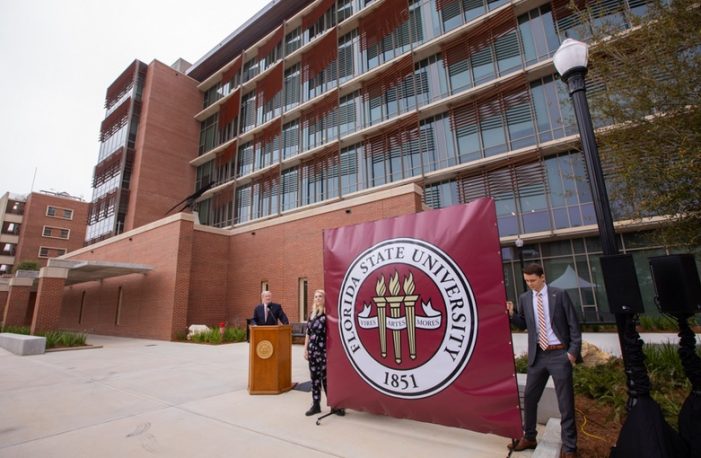By Tom Morgan, FSU News
Florida State University marked the official opening of its state-of-the-art Earth, Ocean, and Atmospheric Science Building and paid tribute to one of the university’s former presidents during a ribbon-cutting ceremony Wednesday.
“We would not be here today if Dr. Barron did not recognize the need for this facility and make it a priority,” President John Thrasher said. “He got the ball rolling and secured the first round of funding for this building six years ago.”
Former FSU President Eric J. Barron and his wife, Molly, returned to FSU for the grand opening and dedication of a statue commemorating Barron’s service at FSU. FSU trustees, along with EOAS faculty, staff and students also attended the event.
Barron, who served as the university’s 14th president from 2010 to 2014, is a 1973 Geology alumnus. Under his leadership, FSU merged three departments, creating what is known today as the Department of Earth, Ocean and Atmospheric Science.
Barron also set in motion plans to build a new home for the department that would house all of the different disciplines.
At the time, students and faculty were scattered across eight buildings, said Dean of the College of Arts and Sciences Sam Huckaba. The next step in ensuring efficient delivery of such an education was to bring the department together under one roof.
“Over the years, a large number of people have worked hard and put in
a lot of time to make this happen,” Huckaba said. “It’s impossible to
thank everybody.”
FSU students and faculty in environmental science, geology, meteorology
and oceanography will now study, learn and conduct research in the
130,500-square-foot space, which includes 23 research labs and eight
teaching labs, a broadcast studio for meteorology students, a 280-seat
auditorium and a 100-seat active learning classroom.
“The Earth’s climate is determined by complex interactions between land, water and the atmosphere, so it makes sense to have scientists in those fields work together,” said James Tull, a geology professor and the department’s chair from 2013 to 2019.
At seven stories, the new building has overtaken Doak Campbell Stadium as the highest point on campus and now towers over Tennessee Street at FSU’s Woodward Avenue entrance. The exterior features a brick façade complemented by a five-story, glass-and-metal window installation by the Master Craftsman Studio that features the FSU torches.
FSU broke ground on the building in October 2016, and the first occupants began moving in at the end of the Fall 2019 semester.
EOAS Chair Vincent Salters emphasized the new space will encourage communication and collaboration across disciplines, and the building’s resources may serve as a catalyst for new interdisciplinary projects in addition to allowing students to get hands-on experience.
Some of the building’s specialized features also will benefit the public, including a seismometer, solar flower, and Science on a Sphere — a display of global data such as atmospheric storms, earth quake occurrences, climate change and ocean temperature that can be shown on the sphere.
The new building, with its multipart mission to aid and expediate cutting-edge research and serve as a place of learning, will attract some of the best students and faculty in the country, Salters said.


Seeing how this is a state-of-the-art Earth, Ocean, and Atmospheric Science Building, is it fully 100% Solar Powered?